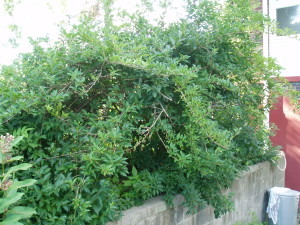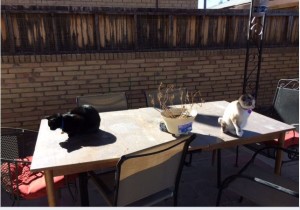(continuing last week’s discussion of our nature walk in the suburbs):
Around many of the houses up and down these suburban streets are a variety of primarily solitary trees. Houses of styles that were built in the 1950’s or 1960’s have significantly larger trees than those houses of styles built in the 1970’s. There were, however, very few “old” trees (trees that were of obviously greater age than the surrounding houses) anywhere in the neighborhood. My assumption is that when this housing plan was laid out there were either very few trees of great age (this may have been part of a set of old farm fields) or the larger, older trees that were here were cut down to make positioning of the streets and houses easier. The most common trees in the yards are Norway maples, blue spruces, Norway spruces, and silver and sugar maples. The spruces are of substantial sizes (more than a foot in diameter and 40 to 50 feet tall) and have broad growth forms with little branch shading or limb pruning. Only in a very few cases, though, are any of the trees in branch contact with each other. For the most part, the trees are widely separated and quite isolated. Yellow birch, European white birch, yellow poplar, cherry, and crab apple trees are also growing in some of these yards along with a variety of shrubs including rhododendron, azalea, burning bush, yew, privet, Rose of Sharon, forsythia, lilac, and a variety of forms of arbor vitae.
Now without getting too preachy or picky about the subject, it is important to consider the idea of “native” vs. “non-native” plants with regard to these tree and shrub species. The three most abundant trees are introduced, exotic species. The Norway maple is native to eastern and central Europe and has been, primarily because of its tolerance of a wide range of site conditions, extensively planted throughout the eastern United States. Its attractive shape and dark, reddish colored leaves also make it a striking addition to many landscaping schemes. The Norway maple, though, because of its prodigious production of seed and its tendency to form dense thicket masses in untended ecosystems, is classified by the National Park Service as an alien, invasive plant that should be avoided. The escape of this species into the wild has done a great deal of damage to native plants throughout the eastern United States. The Norway spruce (which is native to northern Europe) and the blue spruce (which is native to western North America) have also both been widely planted as ornamental trees throughout the United States. Their respective reproductive and growth patterns do not generate invasive or destructive responses in unmanaged ecosystems, although both have “escaped” extensively from landscaped systems into surrounding forests and both have, undoubtedly, had some negative impacts on competing, native tree species.
Rhododendron, arbor vitae, and some (but not all) of the azalea types are native plants in our region. Burning bush (which comes from northeast Asia), privet (of which there is a European form, a Japanese form, and a Chinese form), Rose of Sharon (which comes from southeast Europe and southwest Asia), lilac (which comes from Europe and Asia), forsythia (Pictured to the left) (which comes primarily from eastern Asia), and yew (which comes from England) are all exotic, introduced shrubs. Of these plants only the lilac and the English yew are classified as “non-invasive,” although both are recognized as having frequently “escaped” into surrounding ecosystems. The other species (burning bush, privet, Rose of Sharon, and forsythia) have not only widely escaped but also have caused, according to the U. S. Forest Service, via their dense and destructive growth patterns, widespread declines in many native plant species.
There were a few flower beds observed during our walk. Roses (a very old domesticated flower which probably originated in the Middle East thousands of years ago) were quite abundant, as were crocuses, daffodils, and tulips (all of which are from southern Europe, North Africa, and Asia).
We saw three gray squirrels (a native North America species!) on our hour walk through the neighborhood. Each squirrel was seen running casually across an open area, moving from one tree’s cover to another. The squirrels seemed very tame and unconcerned with nearby people or vehicles. My guess is that the town has a well obeyed leash law for dogs, and that these squirrels have few potential predators with which to concern themselves.
We saw three dogs being walked on leashes. These animals greeted us in calm, dog-like fashions and wagged their tails at us as we passed. We also saw three yard dogs who expressed their extreme dislike of our being anywhere near their houses. Two of the yard dogs had receivers on their collars and were “contained” by electronic “invisible” fences around their yard peripheries. Both of these dogs, in very disconcerting fashions, rushed up to the sidewalk edges of their electronic borders barking wildly as we went by. The third yard dog was restrained by a more conventional (and visible) fence and barked more sedately as we went by. The restraint and containment of these dogs greatly reduces their potential influences on the neighborhood ecosystem.
We only saw one cat on our morning walk (pictured to the left are my daughter’s cats (Binx and Mora) whom I have been trying to include in a blog for some time now!). The neighborhood cat was sitting on the outside sill of her front window watching the events of her neighborhood with an inscrutable calm. We, of course, as only cat lovers can do, made fools of ourselves waving at her and calling to her as we passed. She responded with a tired blink.
There are 38 million households in the United States that have cats as pets (a total of 60 million individual cats). There are additional 60 to 70 million cats in the United States that are classified as feral (a topic I discussed in a blog last Fall). These feral cats live not only in the countryside but also in urban areas (in alleys and abandoned buildings) and in suburban neighborhoods like this one. They live in groups called “colonies” and by maintaining primarily nocturnal activities often successfully avoid both detection and capture. Cats eat 5 to 8% of their body weight daily (a female feeding kittens (which is a common condition in the feral cat colony) eats 20% of her body weight daily). These feral cats, along with free-ranging house cats, kill millions of birds and small mammals (rodents, rabbits, squirrels, chipmunks, etc.) each year in order to survive. Their impacts on the bird and mammal populations of our ecosystems are substantial. Cats are not native to North America. They were brought here from Europe and Asia and, based on the impacts they have on our native fauna, they should be classified as an alien invasive species!
Birds observed on our walk included English sparrows, European starlings (both of which are alien invasive species), common grackles (pictured to the left), American robins, and mourning doves. Notably absent were northern cardinals, song sparrows, chipping sparrows, house finches, blue jays, chickadees, and dark eyed juncos (birds that I know to be quite abundant in the area). No bird feeders or bird baths were observed, but we assume that there were some in the back yards of at least some of the houses. In the United States, according to the Ecological Society of America, 43% of people feed birds. Bird feeders have many positive and also a few negative impacts on wild bird populations. Obviously, by providing a reliable and abundant source of high quality food, birds are better able to reproduce successfully when there are feeders in their home ranges. But, crowding of birds at a feeder can accelerate the spread of some diseases and also increase the presence and activities of predators (including hawks, owls, and house cats).
Robins, of course, would not come to a feeder to eat seed. The robins we observed were busy searching through the expanses of lawns looking for any signs of earthworms. Interestingly, although the robins are a native species, the earthworms for which they are searching are not. These large, “lumbricid” worms (of which the “nightcrawler” is an excellent example) are familiar to anyone who has ever gone fishing or gone out for a walk on a damp, cool morning. These worms are very important to the diet of robins, but they are, in fact, exotic species. European settlers brought these earthworms with them either intentionally or, more likely, inadvertently in pots and bags of soil around roots of transplanted trees and other plants or in association with some of their agricultural animals, tools, or other materials. The staggering numbers and broad ubiquity of distribution of these European earthworm species all across North America are amazing. It is hard to believe that a group of organisms this common and this widely occurring is not native. We often think of the benefits to soil structure and rates of leaf litter decomposition associated with these worms, but there may also be a downside to their activities. Their destruction of the covering layer of leaf litter may have caused the decline and or extinction of many litter dwelling insects and may have irrevocably altered the energy dynamics of forest litter decomposition and nutrient cycling. That these European earthworms are quite abundant in the soil covered by European grass species that is shaded by European trees, though, has some very logical symmetry to it.
The nature of the dominant neighborhood plants generates very little in the way of non-birdfeeder food materials. Also, the almost total lack of any natural, surface water sources greatly inhibits the establishment of significant populations of wild birds. The presence of the Norway and blue spruces and the English yews generates some protective nesting habitats for a wide range of bird and small mammal species, but the wide spacing between these trees and shrubs and the close proximity of any number of noisy and potentially disrupting human foci would be expected to reduce the quality of these nesting habitats. I hope that there are significant numbers of feeders and bird baths in the hidden areas of the back yards although, the very small numbers and low diversity of observed birds and mammals would suggest otherwise.
So, this is suburbia. A hodge-podge ecosystem of mostly alien invasive plants kept in an extremely unstable configuration via the near constant investment of resources and energy. We could construct a much better, more productive and more stable suburban ecosystem, I am sure, if we only would give it a little thought. Rising fuel costs and declining oil resources will probably trigger some of these changes over the coming decades. I will keep you posted!







